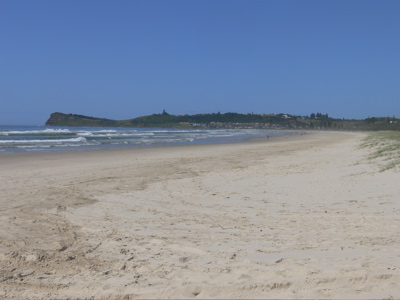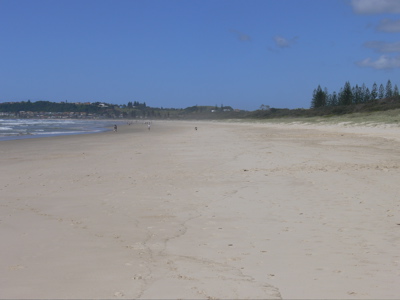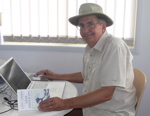Sunday October 21, 2007 6:00 am Lennox Head, NSW Australia
A. Morning Musings
6:00 am
I am beginning to realize that my plan for writing some essays is likely to be difficult until I am back home and have regular high-speed internet access. It is also a matter of priorities. At the moment I have other items that I value more than essay-writing: birding in Australia, reading Australian fiction, getting back to mathematics as well as simply enjoying our time here. I feel better already.
We have almost two full months left before we return to Lethbridge. I have all of my books in front of me. It is easy to place them into groups and sub-groups.
- Literature
- "In Search of Lost Time: The Fugitive" (vol. 6) by Marcel Proust
- "Selected Poems" by Less Murray
- "A Very Close Conspiracy" by Jane Dunn
- Philosophy
- "The Rough Guide to Ethical Living" by Duncan Clark
- "The Omnivore's Dilemma" by Michael Pollan
- Science
- "The Revenge of Gaia" by James Lovelock
- History
- "The War of the World" by Niall Ferguson
- Psychology
- "A Whole New Mind" by Daniel Pink
- Math
- "Deep Simplicity" by John Gribbon
I would be delighted if I can have all of these read before we leave. A related issue is that raised by Alberto Manguel in his book, "A Reading Diary". He picks a novel a month and writes about the relation of each book to other events in his life as he reads. However there is no reason to limit oneself to fiction. But it is important to learn how to leave better breadcrumbs, both of the day as well as my views on the reading. At the moment it is very Spartan, usually just a title and an indication of how much time I spent on the activity. I need to work at providing more reflective comments.
Let's begin.
| Immediate |
Description |
Time |
| Science |
Begin reading "The Revenge of Gaia" |
2 hr |
| Mathematics |
Weiner exercises: |
1 hr |
| Literature |
The Nelson Introduction to Literature (short stories) |
1 hr |
C. Actual Learning Activities
8:40 am
I have selected James Lovleock's new book, "The Revenge of Gaia" for two reasons. One, I remember reading his earlier book "The Ages of Gaia". The perspective of thinking of the planet Earth as a living organism was new to me at the time, but I have never forgotten it. That is a striking testiment to the idea, as I have read very many books that I cannot recall at all. Two, a good friend lent me his copy of this new book when it first came out last year and I promised myself that I would have a close look at it, but could not find the time at that moment to settle down and read it carefully. This morning I have the time.
How to begin? At the back cover, naturally. This often provides a couple of snapshots of the important points. This is not a novel where I would be concerned about sensing the ending before I read the story. This is a serious book of nonfiction where I want to be sure to understand as much of the message as possible. Here are two quotes from the cover: "Truly terrifying" and "Gaia will survive in one form or another. Lovelock's chilling question is: Will we?". This looks like a non-trivial book.
Opening the cover I see that the book has a subtitle, "Why the Earth is Fighting Back - and How We Can Still Save Humanity". At least we are not yet doomed, at least if Lovelock is on the mark. But already I sense it will be a challenge. And then there is the double-edged sword of what if Locklock is wrong. He could be wrong in that there is no hope. Or he could be wrong that there is a serious problem.
The book contains 9 chapters plus a Foreward. This provides a map of the book and should be reread before beginning each chapter. I have created my own headings for these chapters.
- Background
[60]
- 1. The State of the Earth [18]
- 2. What is Gaia? [31]
- 3. The Life History of Gaia [11]
- Predicting the Future
[102]
- Forecasts for the Twenty-first Century [23]
- Sources of Energy [51]
- Chemicals, Food and Raw Materials [28]
- A Plan for Survival
[39]
- Technology for a Sustainable Retreat [10]
- A Personal View of Environmentalism [14]
- Beyond the Terminus. [15]
Noticing the uneven length of the chapters, I have put the number of pages for each chapter in square brackets. Thus the overall book consists, at least in my mind, of three sections of lengths 60, 102 and 39 respectively. This seems about right to me. The background is about 1/3, the main arguments about half, and the final conclusion about 1/6.
Another book that provides a chilling alternative to Lovelock's analysis and scenarios is that of Cormac MacCarthy's "The Road". I read this earlier this year and thoroughly enjoyed it. The phrase "Truly terrifying" also applies to this book. It contains no analysis, and no sense of what happened or why, but describes in chilling detail the consequences of a global catastrophe. The two books make a good combination.
Now to skim through the book and look at the pictures. There are a few graphs and global images showing various predictions as well as trends. There is much evidence of global warming but the image that really caught my eye was one of the planet under different climatic predictions. Compared to the present, the images showed the distribution of life under a case of plus and minus 5 degrees. Under the case of a rise of 5 degrees, the amount of the planet that could support life would decrease dramatically. What surprised me was the alternative scenario of a decrease in average temperature of 5 degrees. This would result in a dramatic rise in the level of life-supporting areas, both on land and in the oceans.
I feel that I have a good sense of the book already. Now to begin reading. I will aim to complete the Foreward and first chapter at one sittig. I will make a light mark in the margin when I see something that merits attention. Then I will see what I want to write.
Rather than capture a number of striking quotes, I will try to identify the main points from the first chapter.
- nuclear fission energy is our best alternative for energy in the near future but nuclear fusion should be the long-term goal. Ideas of renewable energy are not practical - this includes wind power (but he makes no mention of solar power in this chapter).
- global warming will continue and we need to begin planning for the rise in sea level.
- our largest problem is that we still act like small isolated tribes and put such interest above that of a global perspective
- sustainable development is a myth. We need to think in terms of a sustainable retreat until we reach a balance between what we need and what we can provide. We need to think in terms of a smaller footprint at all levels: personal, national and global.
- we need to reduce dramatically fossil fuel consumption (cars, trucks, airplanes) and stop natural forest depletion.
Here is one quote, taken from the Preface by Crispen Tickell: "The Earth system behaves as a single, self-regulating system, comprised of physical, chemical, biological and human components. The interactions and feedbacks between the component parts are complex and exhibit multi-scale temporal and spacial variability." [p. xiv]
This has been a sobering but enjoyable morning read. I am already familiar with the two key ideas of the book: conceptualizing the Earth as a living organism and the idea of a self-regulating feedback system so I do not have to struggle with the framework but can focus on some of the details. Many people reading this book may have difficulty appreciating these underlying ideas which are so important.
At a very personal level, this book is a signal that I should give serious thought to no longer taking airplane trips (i.e. no longer visiting Australia!), selling our truck (and no longer taking trips with our 5th wheel), perhaps buying a newer model 4-cylinder car and using it primarily for short trips. The idea of buying food that is grown nearby would also help reduce the truck traffic required to provide such food to market.
9:00 am
Here are two photos of Seven Mile beach, taken on our morning walk:
looking south toward the Lennox headland


9:30 am
Well, this has been an interesting morning. We had a thorough discussion of the pros and cons of keeping our car here and have agreed that it makes sense for us to sell it just before we leave Australia and to keep our options open as to when we might return. I think we are both feeling much better, now that we have made that decision. Now everything is much clearer with respect to what we need to do while we are here.


